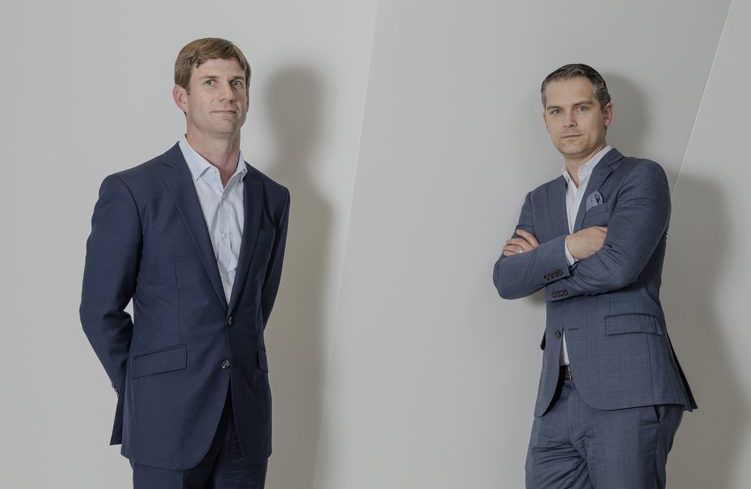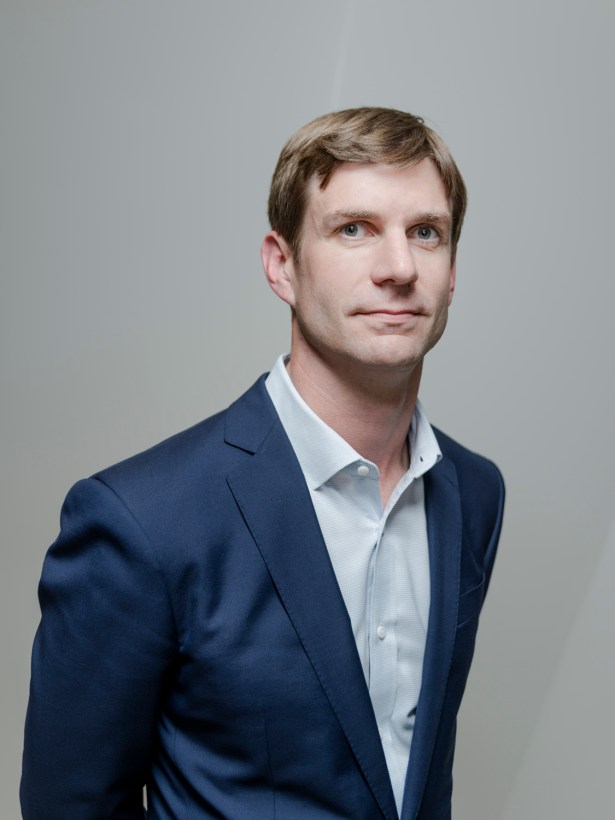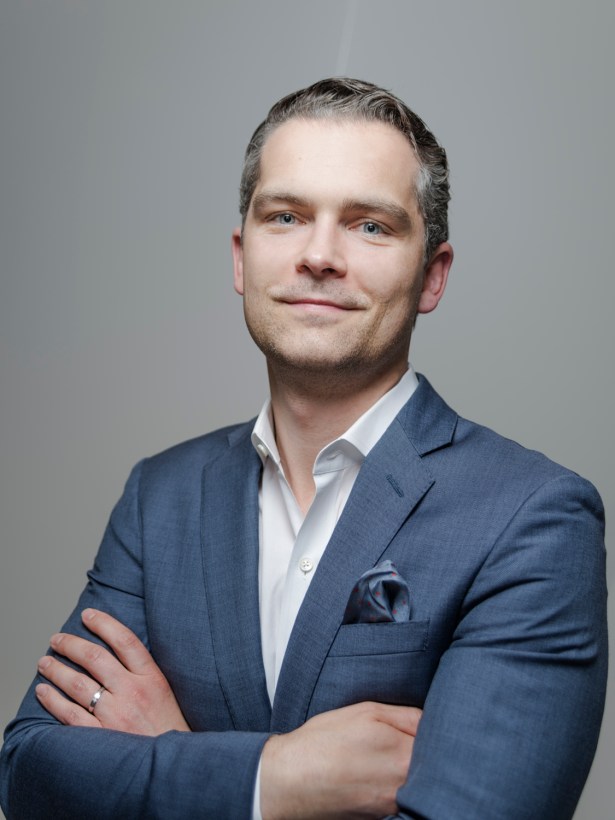Invesco’s Bert Crouch and Yorick Starr are Lenders With a Borrower’s Mindset
By Cathy Cunningham June 4, 2019 11:00 am
reprints
Bert Crouch and Yorick Starr had a meet-cute.
Starr took over Crouch’s role in Wells Fargo’s real estate merchant banking group in 2006 but they never crossed paths.
Crouch, meanwhile, had gone over to Invesco Real Estate, the global behemoth with some $69 billion assets under management and 21 offices in 16 different countries.
A few years into his role at Invesco, Crouch was looking to grow its real estate structured investments group. One guess who came in for an interview.
“I didn’t put two and two together until I sat down with Bert when he was looking to hire and it suddenly clicked,” said Starr.
The two were essentially following the same career path—just at a small lag.
Starr “was walking me through how the Wells Fargo team was structured and I was like, ‘You know, I was there and did exactly all of those things, right?’ ” laughed Crouch.
Now they’re flexing Invesco’s lending muscles together. The team racked up $2 billion in loans in 2018, including the $349 million refinance of 110 William Street on behalf of Savanna and KBS Capital Advisors, and the $250 million refinance of Normandy Real Estate Partners, Meadow Partners and AM Property Holding Corp.’s 80-90 Maiden Lane.
But it hasn’t been all Big Apple trophy office deals. All major property types are considered, but multifamily properties are right in Invesco’s sweet spot and comprise a large chunk of its lending portfolio. Case in point, it recently closed a $80 million senior loan on a 344-unit, mid-rise apartment project known as Bella Posta Apartments in San Diego, Calif., on behalf of Sares Regis Group.
Several of the debt platform’s borrowers are also joint venture partners on the equity side of the business, which only buoys their team’s increasingly busy pipeline.
“What we’ve been able to take advantage of at Invesco is using the broader platform and providing financing solutions for our borrowers using our experience as a very large borrower ourselves,” Starr, a senior director and investment officer, told Commercial Observer last month. “We understand what drives a borrower’s decision and what type of financing they need to be successful.”
Today, the duo is putting their like-minded approaches to good use and are busy originating loans in Invesco’s 45 core markets.
“Yorick and I operate under the ‘keep it simple’ mantra,” Crouch, a managing director and portfolio manager, said. “Keep the capital stack simple and keep your place in the capital stack simple. Keep it defensive and make it so that you can control it.”
Commercial Observer: Bert, you grew up in Dallas. What was your path to Invesco Real Estate?
Bert Crouch: I started my career in commercial banking at Wells Fargo and then did a credit management program in San Francisco. I really enjoyed it and ultimately ended up in New York in 2003, and that’s where I got into real estate. I’d like to say I had a grand vision, but I was really drawn towards the credit side of the business early on—the argument being that if you understand credit you understand the majority of the capital stack. As my career was developing in 2005, real estate capital markets were becoming much more efficient; much more structured, much more complex. But when you looked at the other alternative asset classes, real estate was the least efficient and most fragmented. So, that inherently created an opportunity.
You landed in New York at a pretty good time for the industry.

BC: It was a blast. The industry was really changing at that point. You’d come out of the dot-com [crash] and CMBS was really in its stride. The opportunities we were working on in [Wells’] merchant banking group were unique and bespoke. We were solving a problem with a sponsor while the capital markets were evolving, and there was no better place to be than New York.
What was your mandate when you arrived at Invesco in 2009?
BC: Invesco has been committed to real estate since the 1980s, so you have a leading pure-play fiduciary with a phenomenal reputation. I was brought in with my credit background and they said, “Look, we recognize there’s an opportunity here [because of the crisis], and we want to take advantage of it.” So, I was given a fairly broad mandate to go and execute or exploit those inefficiencies, and that’s exactly what we did.
Which inefficiencies specifically?
BC: A lot of the legacy [loans] overhang, so stress and distress. Invesco came in with an opportunistic focus, which is why I say the mandate was broad—and very exciting. We had a phenomenal team and one of the differentiators is we had over 200 investment professionals dedicated to real estate nationally and 450 properties in our portfolio, excluding the credit side of the business. So, with the depth and breadth of that experience in what I could cover nationally with our relationships, I could step back and say, “Okay. Where’s the relative value?” Because I could access all of it with the existing infrastructure that we have. So, we took advantage of it to expand our mandate and grow globally.
Yorick, you were born in Europe.
YS: I was born and raised in Switzerland, moved to California, and went to college in San Diego. Similar to Bert, for the first few years I was in a specialty finance shop that was acquired by Wells Fargo. I dabbled in real estate there and then moved to New York [in 2005] because one of our main clients was here in New York and I was back and forth a lot. By 2006 there was a courtship between myself and the Wells Fargo real estate folks. Bert had just left, and his boss said, “We need to fill the void here.”
How old is Invesco’s lending arm?
BC: We were founded in 1983 and have tactically been a lender since then. As we went through the crisis we were constantly assessing relative value on a risk-adjusted basis, although credit wasn’t as attractive as it is today—but credit is in the DNA of the firm. We really leaned back into credit in late 2012 when we were still seeing inefficiencies in the capital markets. But in 2011 we had an existing sponsor whose deal had fallen through on a Chicago office building. They needed a recap and needed to do it quickly. The returns weren’t opportunistic but, on a risk-adjusted basis, they were super attractive. We raised our hands and said look, this is something we can do and really scale. So, we hired top talent, like [L.A.-based Managing Director and Investment Officer] Charlie Rose and Yorick, which was a huge hire for us strategically in the east. Then we hired Teresa Zien [a senior director in the capital markets group, based in Newport Beach, Calif.]; she’s been phenomenal and manages all of our liabilities.
What’s a typical loan for Invesco today?
YS: Every transaction is different. We tend to focus on larger deals, so $50 million-plus on whole loans and $20 million on mezzanine. We really focus on credit over yield. Leverage-wise, we provide 65 to 75 percent loan-to-value. We focus on all asset classes, but we’re focused on the 45 markets we’re most active in. We’re a relationship platform; we’re in this for the long term and we’ve done several loans with repeat clients of ours.

It’s a competitive market out there. How are you differentiating yourself from the herd?
BC: The differentiator factor or niche where we find less competition is somewhere between some of the banks and some of the higher-yield [seeking] alternative lenders. If there’s a transitional business plan but moderate leverage and strong and well-capitalized sponsorship with good collateral? That’s where we’re willing to stretch. So we can be competitive on pricing and flexible on terms. When we were focusing on building the lending platform we thought about the borrower side and what annoys us about banks and alternative lenders. Things like inflexible prepayment, inflexible release pricing and forced future funding. So, to the extent that we can alleviate those issues and then have this niche space between those two [lender types]—we’re less regulated than banks and less rigid but also not stretching for the higher return through excess leverage—there’s a real need out there. Then we can also offer quick closings and asset management.
What’s primarily driving the urgency to close deals quickly today?
YS: It’s the competitive nature of the market and how you differentiate yourself when there are several people bidding on the same piece of real estate. You have to be able to say, “I’ll close right now and here is my hard deposit.” That’s the way it’s become, and sponsors thankfully have relationship lenders like us to call.
Banks used to always pride themselves on being the relationship lenders in the industry. It’s interesting that alternative lenders are now often beating them at their own game.
BC: With where we are in the cycle we’ve seen several groups pull back and that makes borrowers anxious. I literally sit on our investment committee so can tell them that, yes, we’re going to get this deal through, as opposed to “our credit committee is fickle”—which doesn’t provide any surety of execution when you just went non-refundable as a buyer.
YS: Intermediaries and borrowers know when we issue terms, we’re going to honor them. We won’t put out terms that we don’t know we can close on.
Would you say the equity side of Invesco’s business gives you a leg-up as a lender?
YS: I believe it does. I know others would give you the other side of the argument, but when a borrower asks us for something, we understand specifically why they may need it—for example, some flexibility on term, or whatever their request may be.
BC: A good example of this is 110 William Street. We know that submarket and we were confident in the business plan. A lot of our sponsors are [our] joint venture partners on the equity side, so they look at us as partners, not lenders. They know we’re not simply solving to a credit box. We’re solving to what makes sense for the sponsor and is consistent with our credit discipline.
YS: With that deal, the [sponsors] came to us and said, “We need this to be done very quickly, we have a deadline by which this has to be refinanced.” It’s a big loan, but they knew our lending platform had the ability to take it down. So we did it in only three and a half weeks and took it down all ourselves—and during a time when the capital markets were a little uneasy. So that was an added advantage; there was a tremendous amount of comfort with us being able to execute.
Does that surety of execution come down to the infrastructure behind you?
BC: Absolutely. [Senior Investment Officer] Rob Deckey, who runs transactions for the northeast, is very well respected. With 110 William he knew the business plan and we, as lenders, didn’t have to get up to speed. He said, “Great sponsor, great operator, we’ve seen them execute in our JV and we love this business plan, we know it cold.” So, we’re not debating if the business plan works and we’re not waiting for the appraisal to come in. We’re buying $5 billion of assets in the U.S. each year and selling $2.5 billion. That insight allows us to think like a borrower and move super quick.
Has Invesco previously worked with the majority of the sponsors it has lent to?
BC: If you look at our production so far this year, half of those are repeat borrowers.
YS: We’re so intermingled with them in so many ways, we’re a big borrower so we also borrow from folks we’ve been lending to. Then you have the partnership of working with Rob Deckey and Josh Siegel [senior director of acquisitions]. We pride ourselves in giving clients access to executive management. It resonates; they can get equity but also debt from the same family.
So, a one-stop shop, essentially.
BC: Yes. That’s one thing that has really expanded since I got here; the depth and breadth of different capabilities that we have, from core to value-add, opportunistic and credit. We can really be a solutions provider to the extent we like the collateral and the real estate.
How do the debt and equity sides of Invesco’s business interact on a day-to-day basis?
YS: We’re basically an extension of what they’re doing as they actively invest in the market. We sit down every week and look at the pipeline. The deals that are great for us are the ones where [the team] might have chased it from the equity side but for whatever reason it got away from us, so we can be very quick in executing as we’ve already done the underwriting. I’m constantly monitoring what they’re working on, and they’re also an extension of the origination side.
BC: Having the broader set of capabilities is hugely helpful. The last three deals Yorick has done in the city have all been with [our equity] JV partners.
What’s your comfort level on the value-add lending side?
YS: I’d say we like lighter value-add. We focus on credit over yield, differentiated real estate in great markets and thoughtful business plans. We’re looking at construction opportunities, which are pretty far along on the value-add spectrum, but we’re very selective and focused on the sponsorship and what is being built. We’ve done one industrial ground-up construction deal, we’ve quoted a handful more and are looking to broaden that to multifamily now.
BC: There’s a lot of recently-developed multifamily where the property is in lease-up and we’re taking out the development lender. Same thing for office—those are the two asset classes we’re heaviest in.
Are you seeing any signs of distress or reminders of the pre-crisis days?
YS: I think, with the competitive nature and where we are in the cycle, we are seeing structure erode around the edges a little. Fortunately, leverage has stayed relatively in check in part because equity needs to be put to work so borrowers take lower leverage.
In terms of transaction volume, what do you envision your total being this year?
BC: We did $2 billion last year. We’re up to $1.5 billion already this year and have a target of $3 billion.
What’s your favorite part of the job, and what keeps you up at night?
YS: For me the challenge is my favorite part. We’re all deal junkies and we love to find ways to get deals done. Leveraging the platform, we’re part of makes things a lot easier. What keeps me up is also being deal junkie; we are in the credit space and there is no room for mistakes.
BC: What I get excited about is we as a team have been given incredible breadth to grow and build a business within a phenomenal organization. It’s a blast.


